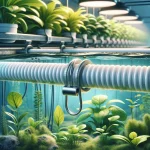Zip ties, those versatile strips of plastic that secure items together, play a pivotal role in the efficient management of aquaponics systems. As aquaponics combines fish farming with hydroponics, organizing the myriad of tubing and equipment becomes crucial. zip ties ensure that these components are neatly arranged and easily accessible, enhancing both the system's functionality and its maintenance.
In this blog post, we delve into the various uses of zip ties in aquaponics setups. We explore how these simple tools help maintain order and reliability in a system that must balance the needs of both aquatic life and plant cultivation. Join us as we uncover the indispensable role of zip ties in this sustainable farming technology.
The Role of Cable Ties in Aquaponics
Zip ties serve as an essential tool for securing pipes and tubing in aquaponics systems. These systems require precise water flow and nutrient delivery to thrive. By using zip ties, farmers can ensure that tubes stay connected and do not sag or disconnect, which could disrupt the entire system. This reliability is crucial for maintaining a consistent environment for both plants and fish.
Moreover, zip ties help in organizing air pumps, water pumps, and filters. These components are vital for the oxygenation and cleanliness of the water, which directly impacts the health of the system. By securing these elements with zip ties, farmers can prevent displacement caused by vibrations or external interference, thus safeguarding the aquaponics system’s integrity.
Benefits of Using Cable Ties in System Maintenance
Maintaining an aquaponics system involves regular checks and adjustments. Cable ties make these tasks easier by holding components in an orderly fashion. This organization allows for quick visual inspections and easier access to all parts of the system. When updates or repairs are necessary, zip ties can be easily cut and replaced, minimizing downtime and disruption to the system.
Additionally, the use of zip ties helps prevent accidents and mishaps in the aquaponics setup. Loose wires or unsecured tubing can lead to trips, falls, or system malfunctions. By securing these potential hazards, cable ties contribute to a safer working environment, crucial in a space that often involves water and electrical components.
Choosing the Right Cable Ties for Aquaponics

When selecting zip ties for aquaponics, it is important to consider material and durability. UV-resistant zip ties are ideal as they withstand exposure to sunlight, a common element in aquaponics systems located outdoors or in greenhouses. These ties will not degrade quickly, ensuring long-term reliability and safety.
Furthermore, it is advisable to opt for zip ties that are adjustable and reusable. These features allow for flexibility and sustainability, as adjustments to the system can be made without the need to constantly replace ties. This not only saves on costs but also reduces the environmental impact associated with plastic waste.
Innovative Uses of Zip Ties in Aquaponics
Beyond basic securing and organizing, zip ties can be used creatively in aquaponics systems. For instance, they can be used to create trellises for climbing plants by connecting stakes or other supports. This application supports plant growth vertically, maximizing space and increasing yield.
Zip ties can also be employed to attach grow lights to the framework of the system, ensuring that plants receive adequate light without complex installations. This adaptability makes zip ties an invaluable tool for customizing and enhancing aquaponics systems to meet specific needs.
Conclusion
Zip ties may be small, but their impact on the efficiency and safety of aquaponics systems is significant. From securing tubing and equipment to facilitating system maintenance and enabling creative modifications, these tools are indispensable in the world of sustainable agriculture. As we continue to explore and expand the capabilities of aquaponics, the role of zip ties remains crucial.
We invite you to explore our website to discover more innovative uses of everyday tools in sustainable farming. Join us in our journey towards more efficient and productive agricultural practices.

